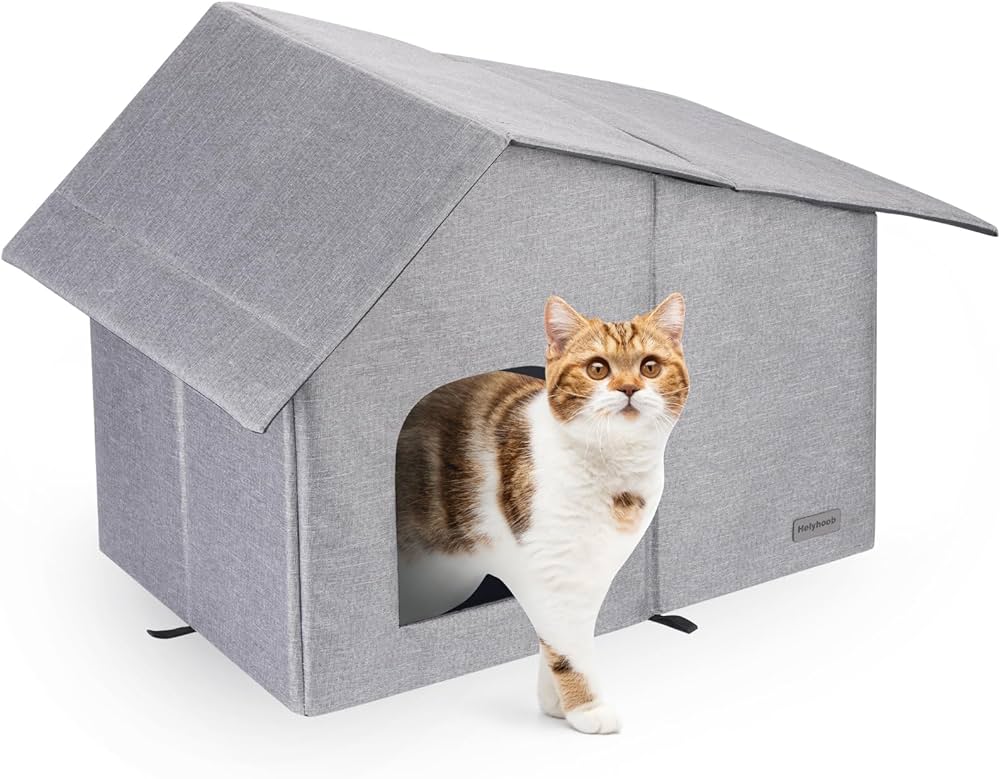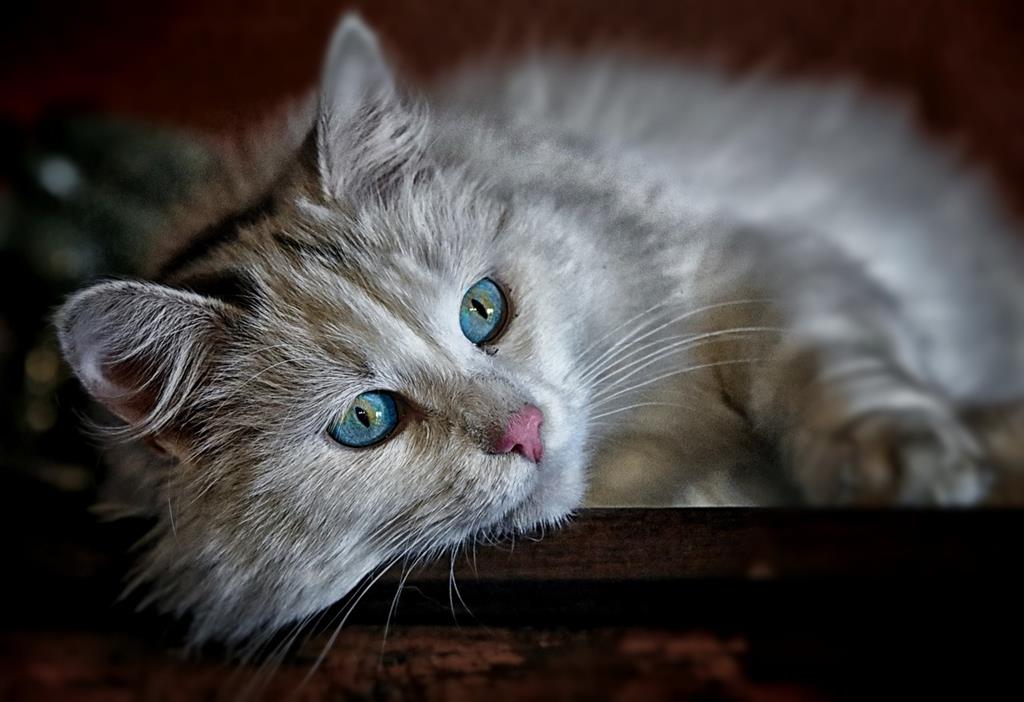In your feral cat house, include insulating materials like straw and tools for temperature regulation such as a flap door. Avoid using towels or blankets, which retain moisture.
Ensuring a safe and comfortable environment for feral cats is crucial, especially during extreme weather conditions. A feral cat house serves as a refuge from the harsh elements, providing warmth in the winter and a cool retreat in the summer.
By utilizing appropriate materials such as straw, which does not absorb moisture and provides excellent insulation, you enhance the shelter’s effectiveness. It’s important to prioritize features like easy drainage and a flap door to keep out wind and rain, creating an inviting yet secure habitat for these independent felines. Selecting the right components for your feral cat house can significantly improve the quality of life for community cats while maintaining their health and safety.
Feral Cat Lifestyle And Needs
Understanding feral cats deepens the bond between human societies and the untamed feline world. Feral cats live a vastly different life from pets, thriving outdoors and following their instinctual behaviors.
Feral vs. Domestic: Understanding the Differences
Feral Vs. Domestic: Understanding The Differences
Many people often confuse feral cats with strays or domesticated cats, but significant differences set them apart. Feral cats are essentially wild animals, having had little to no interaction with humans. Unlike domesticated cats, they are self-reliant, cautious, and adapt to living in the wild. Here’s what to keep in mind:
- Feral cats often avoid human contact.
- They hunt for food, unlike domestic cats that rely on human-provided meals.
- Shelter for them means hidden, safe places like underbrush or abandoned areas.
The Importance Of Shelter For Feral Cats
For feral cats, shelter is a survival essential. It provides refuge from harsh weather, predators, and the chaos of urban environments.
| Shelter Feature | Benefit |
|---|---|
| Insulation | Keeps cats warm in winter, cool in summer |
| Waterproof | Protects from rain and snow |
| Elevation | Prevents moisture and predators from entering |
Providing a proper feral cat house can drastically improve the quality of life for these free-roaming felines. Aim to make the shelter sturdy, waterproof, and insulated with materials such as straw, which will not hold moisture like blankets or towels. The entry point should be small to keep out larger animals and prevent heat loss.
Choosing The Right Cat House
Helping feral cats can be rewarding. A cozy, safe cat house is vital for their wellbeing. Feral cats need shelter from cold, heat, and predators. The right house can be a haven for these community cats. Let’s explore what makes a top-notch cat house.
Materials Matter: Durability & Insulation
The materials you choose for your feral cat house are key. They must withstand harsh weather. They must also keep cats warm in winter and cool in summer. Look for these features in materials:
- Waterproof. Houses must repel rain and snow.
- Rugged. They should last many years.
- Insulating. Straws work well for warmth.
Wooden cat houses are popular. They are sturdy and good insulators. Plastic bins are water-resistant and easy to clean. Line them with straws, not hay. Straws repel moisture, hay does not. Remember to avoid materials that can mold or rot.
Size Considerations: Comfort For The Cat Community
Size is crucial when choosing a cat house. It should be spacious but not too big. A compact size retains more heat. Yet, feral cats enjoy room to move and sleep. Consider these points:
| Number of Cats | House Size |
|---|---|
| 1-2 cats | At least 2 feet by 3 feet |
| 3 or more cats | Increase space by 1 square foot per cat |
Entrances matter, too. Multiple entrances ensure cats can escape if needed. Each doorway should be small to keep out predators. Edges should have no sharp parts. Place the house off the ground. This keeps it dry and warm.
Key Features Of A Well-designed Cat House
When building or buying a home for a feral cat, it’s crucial to consider features that provide safety, comfort, and durability. A well-designed cat house can be a haven for feral cats, especially during harsh weather. Here, we will explore the key elements that make a cat house a shelter where feral cats can thrive.
Insulation Properties: Keeping Warm In Winter
Effective insulation is vital for a cat house to be a refuge during cold months. Materials like straw or Styrofoam liners serve as excellent insulators and retain heat. Key insulating features include:
- Thick walls that prevent heat loss
- Self-heating pads or microwavable heating pads for added warmth
- Covered entryways to block drafts and maintain a cozy interior
Ventilation: Ensuring Fresh Air Flow
A well-ventilated cat house is essential for healthy air circulation. Even in winter, fresh air helps to prevent moisture buildup and maintain a comfortable environment. Key ventilation features include:
- Small air holes located near the roof to allow airflow without letting in snow or rain
- Adjustable vents that can be opened or closed depending on the weather
- Designs that prohibit the entry of predators while promoting fresh air
Ease Of Cleaning: Maintenance Tips
A clean cat house is crucial for feral cats’ health and well-being. A house that is easy to clean will ensure a hygienic space for cats to live. Maintenance tips include:
- Removable roofs or floors for quick and thorough cleaning
- Smooth, non-porous interior surfaces to simplify wiping down and disinfection
- Build materials resistant to mold and mildew to maintain a healthy environment

Credit: www.amazon.com
The Essentials Of Cozy Bedding
Creating a snug retreat for feral cats is vital, especially during harsh weather. The right bedding serves as a warm sanctuary. Let’s dive into what makes the perfect bed for these stealthy felines.
Suitable Bedding Materials
Choosing the best materials is step one. Here are some top picks:
- Straw: It repels moisture and keeps felines warm.
- Fleece blankets: Soft and warm, they’re a feline’s dream.
- Wood shavings: Excellent for insulation and easy to replace.
- Myler blankets: Reflects body heat back to the cat.
Safe & Warm: Bedding Placement
Placement matters as much as the materials.
- Place bedding away from openings to avoid drafts.
- Elevate the bed slightly to prevent moisture seepage.
- Keep the bedding compact to enhance warmth.
Weatherproof Solutions For Bedding
Protect bedding from the elements to ensure lasting warmth.
- Cover the cat house with a waterproof material.
- Ensure there’s a flap over the entrance for extra protection.
- Regularly check and replace bedding to maintain a clean space.
Seasonal Adjustments For The Cat House
Welcome to the essential guide on making your feral cat house a safe haven, no matter the season. As the weather changes, so do the needs of outdoor cats. Below, find our top tips for adjusting your cat house for varying temperatures, ensuring our feline friends are comfortable all year round.
Preparing For Cold Weather
Keeping feral cats warm during winter is vital. Start by insulating the cat house. Use materials like straw or hay as bedding. Avoid blankets or towels as they can retain moisture and freeze.
- Seal off any large openings to prevent cold winds from entering.
- Add a flap door for extra protection against the elements.
- Ensure the house is slightly elevated with a sloped roof to avoid snow buildup.
- Consider using a safe, outdoor heating pad designed for pets.
Remember to check the house regularly for damage or wet bedding.
Cooling Strategies For Summer Heat
Hot summer months can be tough on feral cats. Effective cooling strategies are crucial. Provide ample shade by positioning the house out of direct sunlight. Trees or tarps work well for this purpose.
Ensure good ventilation by creating multiple air holes. These should be small enough to keep predators out. Attach a water bottle with frozen water to the house’s side. It creates a cooling effect
- Put fresh water nearby and change it daily.
- Consider using light-colored materials to reflect sunlight.
- Apply a non-toxic, heat-reflective paint to the exterior.
Maintain the cat house frequently to guarantee a safe, comfortable environment.

Credit: twitter.com
Additional Comfort Items
Outfitting a feral cat house goes beyond mere shelter; it’s about creating a haven where these wild felines can truly thrive. Providing additional comfort items can drastically improve the quality of life for your feral furry friends. Such items not only offer warmth and coziness but also cater to their instinctual needs for food, water, and play.
Food And Water Accessories
In the wild, feral cats are accustomed to hunting for their sustenance, but a safe food and water source greatly enhances their well-being. Inside the shelter, it’s ideal to have accessories that keep these essentials fresh.
- Non-tip bowls – These prevent spillage and ensure food and water are always accessible.
- Heated water bowls – In cold climates, these keep water from freezing.
- Automatic feeders – They can provide food at regular intervals for consistent nourishment.
Toys And Play: Enrichment For Feral Cats
Enrichment is key to a cat’s health and happiness. Engaging toys trigger their natural hunting instincts and provide much-needed mental stimulation.
| Toy Type | Benefits |
|---|---|
| Mice or ball toys | Encourage chasing and pouncing. |
| Tunnels | Offer hiding spots and exploration fun. |
| Catnip toys | Stimulate and entertain for hours. |
Rotate toys regularly to keep things fresh and engaging for your feline guests. This simple act can dramatically enrich their lives.
Safety Concerns
Ensuring the safety of a feral cat house is vital for the wellbeing of the stray felines seeking refuge. Addressing safety concerns involves considering threats from predators and environmental challenges. A well-protected shelter provides peace of mind and a secure place for cats to rest and stay warm. Paying attention to specific details can create a fortress against dangers.
Predator Deterrence
Protecting feral cats from predators is critical. Animals like coyotes, dogs, and other large predators pose risks. Simple measures can prevent these encounters. Here are tips:
- Secure the entrance with a small-sized opening. Only cats should slip in with ease.
- Install flap doors that only cats can operate.
- Avoid food inside the house, as it can attract unwanted visitors. Keep feeding areas separate.
- Use motion-activated lights to scare away nocturnal hunters.
Elevating The House: Protection From The Elements
Elevation is another layer of defense.
Raising the cat house off the ground provides numerous benefits:
- It prevents water from entering, during heavy rain.
- Insulates against cold, as the ground can be a source of cold air.
- Safeguards against snow accumulation around the entrance.
- Reduces the presence of parasites like fleas.
Consider these tips for proper elevation:
- Use sturdy materials to support the house.
- Ensure the house is balanced and stable to prevent tipping.
- Place the house on platforms or legs made of weather-resistant materials.
- Check regularly to maintain a safe elevated structure.
Community Involvement
Community involvement plays a crucial role in supporting feral cats. By working together, neighbors can create safe and nurturing environments for these independent felines. Discover how you can contribute to their welfare below.
Educating Neighbors About Feral Cat Care
Education is key to improving the lives of feral cats. Informing your community can lead to better understanding and support. Consider these steps:
- Organize informative sessions about feral cat needs and behaviors.
- Create flyers that highlight the importance of proper feral cat house setup.
- Discuss winter safety tips, like proper insulation for cat houses.
- Emphasize the value of spaying and neutering to control the feral cat population.
Volunteer Opportunities And Donations
Volunteering and donating are direct ways to help feral cats. Explore various options to get involved:
| Opportunity | How to Contribute |
|---|---|
| Build Cat Houses | Join local DIY workshops to construct warm shelters. |
| Donate Supplies | Provide materials like straw, wood, and water-resistant covers. |
| Fundraise | Support vet care and food costs through community fundraising. |
| Adopt a Spot | Take responsibility for maintaining a feral cat house in your area. |

Credit: www.walmart.com
Frequently Asked Questions On What Should I Put In My Feral Cat House
What Is The Best Bedding For A Feral Cat House?
The best bedding for a feral cat house is straw, as it repels moisture and retains heat effectively. Avoid using hay, blankets, or towels which can retain moisture and freeze in cold temperatures.
What Do Feral Cats Like To Sleep In?
Feral cats prefer sleeping in quiet, concealed spots that provide shelter and safety. They often choose areas like dense foliage, underbrush, abandoned buildings, or spaces beneath objects that offer protection from the elements and predators.
What Is The Best Shelter For Feral Cats?
The best shelter for feral cats is a sturdy, insulated outdoor cat house, often made from wood or heavy-duty plastic for protection against the elements.
What Can I Use Instead Of Straw For Cat Shelter?
For a cat shelter, you can use shredded newspaper, hay, wood shavings, or packing peanuts as alternatives to straw. These materials provide warmth and comfort for cats.
Conclusion
Crafting the perfect haven for your feral feline friends doesn’t have to be complicated. Provide warmth, safety, and comfort with simple items like straw bedding, insulation, and a water-resistant shelter. Remember, small touches of care can make a big difference for these independent creatures’ wellbeing.
Share this guide to help others create a hospitable outdoor home for feral cats, and contribute positively to their lives.



